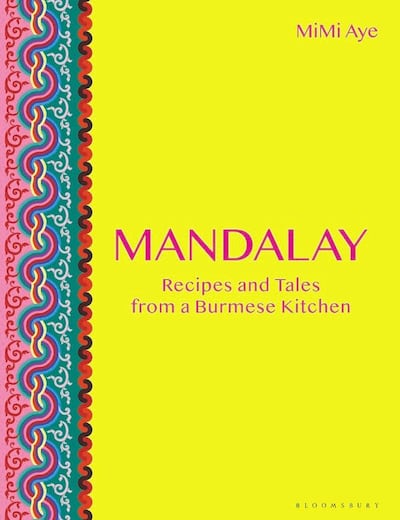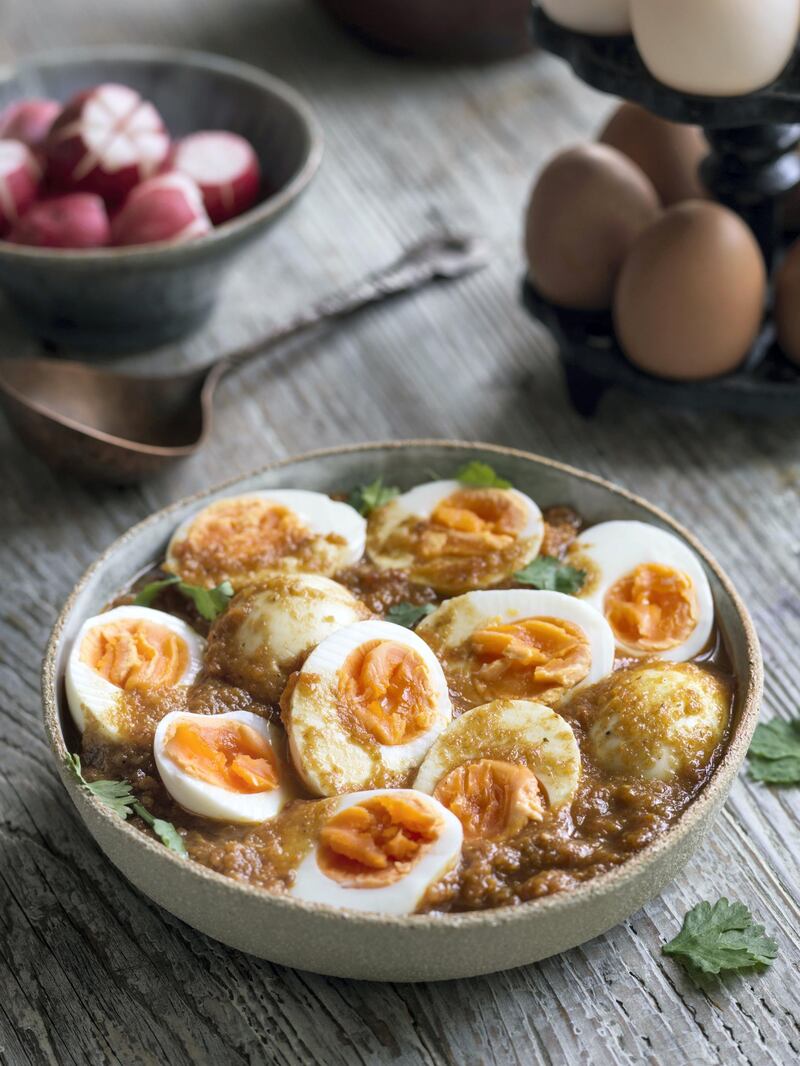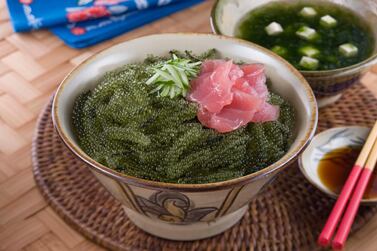"There is a Burmese saying that a marriage will not work if one party likes noodles and the other likes rice," writes MiMi Aye in Mandalay, her wide-ranging introduction to Burmese food. That thought is as close as Ayegets to sounding a note of conflict in this warm, gentle and consoling book, which simmers with a sense of the power of food to delight, nourish and heal.
As for that faint possibility of conjugal battles over rice and noodles, even that can be solved – if the two parties settle halfway on rice noodles.
Aye lives in London and speaks with a cut-glass English accent. She was born in the seaside town of Margate to Burmese parents, both doctors, who had emigrated to England. With all the anxiety of immigrants transplanted to a cultural universe vastly different from their own, she says, they sought to school their children thoroughly in Burmese-ness – and the obvious place to start was food. She remembers annual childhood trips back to Burma to see extended family, and the train from Yangon to Mandalay in the north, where her father came from: a 15-hour journey "on the hardest seats known to mankind" and "with food on my mind".
The memories of those childhood meals are vividly evoked in Mandalay and form the emotional foundation of the book. "Like many mothers around the world, feeding us was how my mother expressed her love," she says, "and this need to nourish has passed on to me. This is a huge part of why I wanted to share Burmese food with the world … that, and the fact that I want to show how fantastic it is."

Burmese food is unusual in that – although surrounded geographically by and drawing from three cuisines (Indian, Chinese and Thai) that are familiar to cosmopolitan eaters – it remains something of a mystery. The coconut-milk-based noodle dish khao swe and tea-leaf salad are probably the only Burmese dishes that appear on catch-all menus of "south-east Asian food". The oblivion is partly self-inflicted: for six decades before the country opened up to the world in 2012, it was ruled by a repressive military junta – hardly the best advertisement for food and culture. Yet, as Aye shows, there is much to admire about Burmese cuisine, which is completely in tune with the trends of our time in being replete with comfort food – flavourful broths, complex salads and aromatic curries – that are also healthy and use loads of fresh produce, even the rice and noodles.
Add to that the thoughtfully worked-in details about culinary tradition (before meals, “a spoonful of rice will be scooped out from the pot and put aside as a form of respect” for the deceased), the little touches of autobiography (supplemented by period photos from the Aye family album), splashes of musing on history and geography, and sumptuous food photography by Cristian Barnett, and what you get is a book that serves as an introduction not just to Burmese cuisine, but to the country itself. (Indeed, food is so central to the self-conception of so many cultures that one feels a cookbook is a much more truthful account of a society than books on history and politics.)

Much can be learnt about the character of Burmese cuisine, Aye explains, by focusing on the one ingredient unique to it: lahpet. Young tea leaves are briefly steamed before being pressed down with weights in bamboo silos, where they ferment and return as a fine base, sour and astringent, moist with a bit of crunch, for salads. (Although lahpet is now available in many good Oriental supermarkets, artichoke hearts are a passable substitute.) The prepared tea leaves are then thrown together with a host of ingredients – crispy fried garlic, roasted chana dal, fried peanuts, dried shrimp and pickled ginger shreds – and finished off with a dressing of sesame oil and a squeeze of lime. The result is an explosive hit of flavour distributed across a wonderful combination of textures.
Not only is lahpet a food of great ritual significance – there are specific lacquerware dishes for serving it, and it was often used in olden times as a peace offering or a sign by both parties in a legal dispute that they agreed to respect the judge’s verdict – it is also used as a pick-me-up by overworked university students because of the caffeine content in the leaves. Think of it as a Burmese Red Bull.
In fact, texture is central to this cuisine, Aye points out, and what is seen as a combination of contrasting flavours – for example mohinga, a much-favoured breakfast dish consisting of a pungent fish broth poured over rice vermicelli noodles and topped "with slices of duck egg, bouncy fishcake and fresh feathery coriander" – is also a feast of different kinds of mouthfeel. Food is usually not served in course, but rather all together, and every meal is presented with a host of condiments in small bowls, so that each person can make a final combination according to their own taste.
Some of these accompaniments, such as ngapi, a fish paste; Burmese tofu (made from chickpeas and turmeric rather than soybeans); and the India-influenced “rainbow pickle” with fresh vegetables marinated in malt vinegar and then mustard, cumin and coriander seeds, are worth close study in their own right.
The only area where Burmese cuisine falls a touch short is dessert. Fruit, especially mangoes when in season, are preferred to confectionery, but a swift, homely touch of sweet is on offer in every household – I tell Aye this reminds me so much of my own childhood in eastern India, not far from Burma – in the form of a lump of brown jaggery made from date palm sap.
What I especially enjoyed about Mandalay was Aye's emphasis on the use of the sense of touch in both cooking and eating. Like Indians, but unlike the Chinese and the Thai peoples, the Burmese often eat food – even the drier kinds of noodle dishes and salads – with their hands. Much of the mixing of ingredients at the cooking stage is done by hand, too – and for good reason, for fingers can do things that tools with straight lines can't.
Aye seeks to educate readers in keeping up this practice, recommending in a recipe for “pan-sticker aubergine”, for example, to massage all the spices into the slices of aubergine, and to toss a Burmese tofu salad together with the hands. Elsewhere, she instructs the reader in the art of making small balls of rice with the tips of the fingers to mix together with gravy, and morsels of meat and vegetables before raising them to the mouth. So much of eating depends on how we eat, and there are many kinds of table manners and techniques, each appropriate for certain kinds of cuisine.
These vivid, grounded touches – little bridges into the matter and manners of another culture, and eventually a road to another way of being – are what, in the end, make Mandalay something deeper than your average cookbook.
Recipe: Be U Chet (duck egg curry)
"I'm a rampant carnivore, but even I can see that it would be better for the planet's future to go meat-free where possible and everyone can do it at least one day a week," writes Aye in Mandalay. "Therefore, I present to you my favourite vegetarian Burmese dish – egg curry aka be u chet (literally 'duck egg cooked'). Some people like to fry the peeled, hard-boiled eggs in turmeric-infused oil until they're golden and blistered all over. I usually don't have the patience, but it's definitely worth a try."
Serves 4
Ingredients
8 duck eggs or large hen's eggs
1 tsp tamarind paste or 2.5cm cube tamarind block or 1 tsp lemon juice
½ bunch of coriander
2 tbsp groundnut oil or other neutral-tasting oil
3 medium onions, diced
400g tin chopped tomatoes
6 curry leaves
1 tbsp paprika
1 tsp ground turmeric
1 tsp chilli powder
1 tsp fish sauce
¼ tsp MSG or ½ tbsp chicken or vegetable bouillon
Method
If using a tamarind block, place in a bowl with 100ml of just-boiled water and allow to soak for 10 minutes – it should break down into a thick paste. Remove the stones and the fibrous bits.
Chop the stems from the coriander and mince them as finely as possible. Chop the leaves and reserve them for later.
Heat the oil in a saucepan, toss in the onions and coriander stems, and add the rest of the sauce ingredients. Cook this mixture down over a medium heat for 1 hour or until it breaks down into a sauce and then keep it simmering gently over a low heat.
Place the eggs in a saucepan, cover with cold water and heat over a high heat until the eggs start to boil and bubble furiously. Immediately turn the heat down to medium and simmer for 4 minutes. Remove from heat, drain and then submerge the eggs in cold, running water to stop them cooking. Peel the eggs and slice each in half – you should have yolks that are perfectly creamy. Stir the halves gently through the simmering sauce to coat. Scatter the egg curry with a handful of chopped coriander leaves and serve immediately with steamed rice and some crudités on the side such as cucumber slices or radishes.







